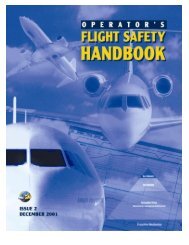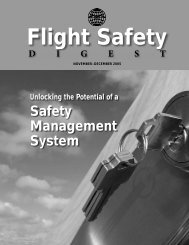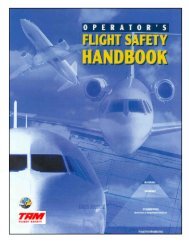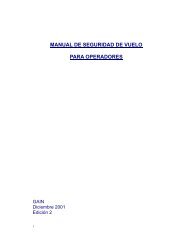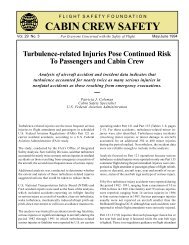Download PDF [10.9 MB] - Flight Safety Foundation
Download PDF [10.9 MB] - Flight Safety Foundation
Download PDF [10.9 MB] - Flight Safety Foundation
You also want an ePaper? Increase the reach of your titles
YUMPU automatically turns print PDFs into web optimized ePapers that Google loves.
Therefore, it requires us to stay alert and vigilant<br />
in front of constant re-engagement towards<br />
more rules and regulations.” 1<br />
Personnel do not have infinite attention<br />
capacity. Under a regime of excessive proceduralization,<br />
they must devote an increasing<br />
amount of their attention to keeping up<br />
with and following rules and regulations. The<br />
corollary is that some time and energy must be<br />
debited from attention to the real-world working<br />
environment.<br />
Trapping <strong>Safety</strong> into Rules is a collection<br />
of chapters examining various aspects of the<br />
theme. Part I is “Where Do We Stand on the<br />
Bureaucratic Path Towards <strong>Safety</strong>?” Part II is<br />
about “Contrasting Approaches to <strong>Safety</strong> Rules.”<br />
Part III includes chapters under the heading<br />
“Practical Attempts to Reach Beyond Proceduralization,”<br />
and Part IV is “Standing Back to<br />
Move Forward.”<br />
Claire Pélegrin, in her chapter, “The Never-<br />
Ending Story of Proceduralization in Aviation,”<br />
traces the evolution of the phenomenon.<br />
“At the beginning of aviation, the designer,<br />
the engineer and the pilot were the same person,<br />
thus there was no real need for procedures,” she<br />
says. It was not long before specialization began,<br />
yet even then, pilots determined their own procedures<br />
and tried for self-enforcement.<br />
World War II brought the need to train large<br />
numbers of pilots quickly and efficiently — as<br />
well as, in some cases, getting pilots ready for<br />
action without optimum training time. Standard<br />
operating procedures and checklists were among<br />
the tools for achieving the goal.<br />
Commercial aviation after the war maintained<br />
and expanded the procedural approach.<br />
“For years, everybody shared the same idea that<br />
safety would be guaranteed if pilots were selected<br />
and trained to strictly apply procedures,”<br />
Pélegrin says. Of course, safety was hardly guaranteed<br />
— for one thing, postwar commercial<br />
pilots lacked the benefits of today’s technological<br />
innovations such as terrain awareness and warning<br />
systems (TAWS), traffic-alert and collision<br />
avoidance systems, and weather radar. But the<br />
procedural emphasis seemed promising.<br />
FLIGHTSAFETY.ORG | AEROSAFETYWORLD | MAY 2013<br />
So it grew, becoming more sophisticated<br />
and elaborate. “Cockpit tasks have been organized<br />
through checklists, do lists and procedures,”<br />
Pélegrin says. “The philosophy behind<br />
[them] is very stringent, dictating the accurate<br />
way of configuring [and] flying the aircraft<br />
and communicating.”<br />
Next in the “never-ending story” came crew<br />
resource management (CRM). Among other<br />
principles, “CRM training emphasized that<br />
[crewmembers] support a shared action plan<br />
and shared awareness, which is essential because<br />
it creates a mental image to act, synchronize<br />
action and manage time. … Procedures<br />
also play an important role in interpersonal<br />
relationships and in conflict management<br />
because they are seen as a neutral reference: In<br />
case of disagreement, following the procedures<br />
is one way to solve conflict. This is taught in<br />
many CRM courses.”<br />
In due season, proceduralization became<br />
generalized to the organization, encompassing<br />
flight operational quality assurance and<br />
today’s widely adopted safety management<br />
systems (SMS).<br />
Pélegrin acknowledges the benefits, even the<br />
necessity, of many aspects of proceduralization.<br />
But they bring drawbacks as well, she says:<br />
“Organizations in aviation are in a vicious<br />
circle with the proceduralization approach. They<br />
started to focus on technical performance of<br />
the technical system (safety analysis and reliability)<br />
to become now focused on the safety of<br />
the socio-technical system. This is not exactly<br />
the same problem and not the same methodology.<br />
Liability aspects are part of the overproceduralization.<br />
The tendency is to use written<br />
procedures as a legal reference in case of legal<br />
suit … and push for more procedures. This may<br />
become counterproductive, the main difficulty<br />
being that everybody may become lost with all<br />
these safety requirements.”<br />
Airlines have to balance an inherent contradiction.<br />
Pélegrin says, “Standard operating<br />
procedures promote the idea of uniformity<br />
and standardization at the risk of reducing the<br />
human role. At the same time, pilots are seen<br />
INFOSCAN<br />
Procedures also<br />
play an important<br />
role in interpersonal<br />
relationships and in<br />
conflict management<br />
because they are seen<br />
as a neutral reference.<br />
| 49


![Download PDF [10.9 MB] - Flight Safety Foundation](https://img.yumpu.com/18550968/51/500x640/download-pdf-109-mb-flight-safety-foundation.jpg)

![Download this Issue [PDF 7 MB] - Flight Safety Foundation](https://img.yumpu.com/18859635/1/190x245/download-this-issue-pdf-7-mb-flight-safety-foundation.jpg?quality=85)
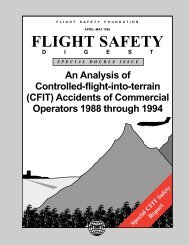
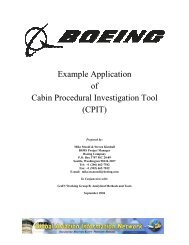
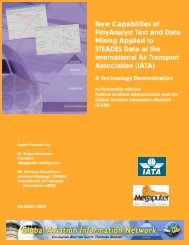
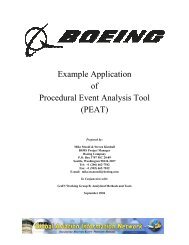
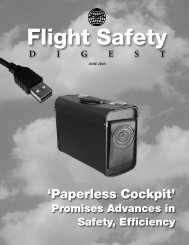
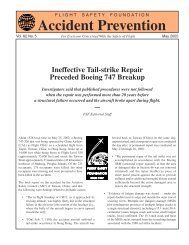
![Download [PDF 8 MB] - Flight Safety Foundation](https://img.yumpu.com/18859366/1/190x245/download-pdf-8-mb-flight-safety-foundation.jpg?quality=85)
